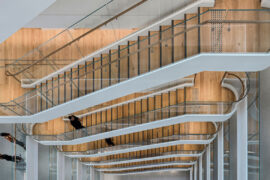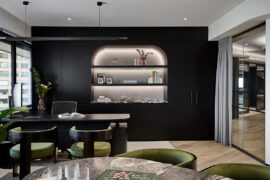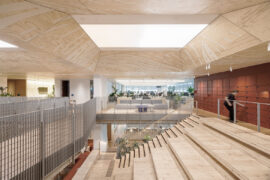Coming straight out of the latest issue of Indesign is a story that sets the tone for the magazine, and it’s all about the shifts in workplaces. Futurespace’s Angela Ferguson and international design icon Tim Kobe open our world up to new possibility.
March 14th, 2018
Creative cross-pollination moves the world forward – a truth I think we’ve all accepted. But if we want to know where the answers to the future of the workplace can be found, we need to cast our gaze beyond the commercial bubble. Elvis Presley for example, changed the future of the music industry when he blended sex (at least the suggestion of it) into his performances – a crossover that had, until then, been unthinkable.
Andy Warhol likewise revolutionised the art world when he rebelled against the aristocratic establishment and proclaimed that the future of the art community could be found in the ordinary, accessible world of pop-culture and stock grocery items – again, a strange and unexpected mixture which proved to be the fuel that the art community arguably needed to survive.

Virgin Atlantic Airways Clubhouse by Eight Inc. is designed to support a next-gen client experience that is smarter, more personal and highly customisable.
Similarly, the next frontier of smart workplace design is cracking the formula on a ‘binary’ user format, where companies are looking to not only improve the performance of their employees but the experience for their clients, too. What remains mostly uncharted is the creation of a unique client experience within the workplace. Traditionally, it’s been all about the workers. In the meantime, our commercial clients are looking to us for leadership, and by necessity we must widen our scope of reference to tackle the challenge at hand.
The aviation industry presents us with some strong solutions in this area, where the world’s top airlines offer best-in-class client experiences from departure to arrival, while also attracting and maintaining the world’s most talented staff – often all within a single environment. It’s everything we’ve been looking for!
For Tim Kobe, founder and CEO of global design firm Eight Inc, the client experience, whether in a workplace, an airport lounge, or a plane, is quite consistent. “I’m not convinced that every company’s needs are so different. Ultimately, the primary role of any company is to serve people in a meaningful and effective way.”
For Kobe, every design should begin from this place, ensuring “that the experience customers have with the brand align and resonate at both a functional and an emotional level”. This was certainly the thinking that drove Eight Inc’s design for premier airline Virgin Atlantic, specifically their series of award-winning transit lounges, the Virgin Atlantic Airways Clubhouses (VAAC).
The initial brief for the VAAC was to provide a sophisticated refuge for Virgin customers before or in-between international flights. “Over the years, the romance has slowly been drained from travel,” says Kobe. Virgin, however, was determined not to let this happen. Organised into several zones, the VAAC offer everything a wear traveller could want, including: a full-service bar; lounges with armchairs for work or relaxation; tables for dining; a business centre; a complete kitchen; restrooms and showers.
The long southern wall is occupied by a window that overlooks the runways, and is shaded by a series of sliding glass panels that create a daily animation of coloured light across a luminous glass bar and reception. Different ceiling heights expand the space vertically, rich mahogany wall panels in the dining area provide a warm contrast to the glass, and sculptural seating elements featuring modern furniture add to the contemporary but comfortable environment.
“We thoroughly considered how the lounge would fit into a broader spectrum of travellers’ various encounters with Virgin Atlantic. I really think that when you stop thinking of your design existing in isolation – in this case, the pre-flight experience, the flight experience proper, and the post-flight experience – you will produce something much greater, more holistic and connected. And that is what’s really valuable in a modern service industry.”
For Kobe, the markings of this next-gen client experience is “smarter, more personal and highly customisable”. In the case of VAAC every possible element of the journey is designed to support this far more comprehensive approach to user experience.
“The quality of the food, the variety of support services that give each type of traveller the right kind of facilities and support – from the business traveller, the solo traveller, or family on vacation – every moving part is considered. For example, there are services and facilities that recognise the needs that people have when they travel, be they personal care and grooming, entertainment, work and/or recreation.”
Futurespace’s Angela Ferguson has long recognised the aviation industry for offering a valuable benchmark for workplace designers looking to set a new standard in quality user amenities. But, she says: “Flexible, tech-enabled workplaces that provide a great deal of choice catering to individual needs and preferences, have collaborative and concentrative spaces, are sustainable, with a focus on health and wellbeing” have only ever been available to the staff. “Innovation when it comes to customer engagement and providing client spaces with the same level of amenity has not evolved in parallel during this time. Until now!”
Ferguson says. “With the finalisation of PwC’s projects in both Sydney and Melbourne, we’ve designed the first in a new wave of projects that herald the death of the boardroom as we know it.”
Perhaps the boardroom isn’t dead quite yet. But, as Ferguson says, businesses now want to engage with their clients similar to how they engage with their staff. “The old Mad Men-style of client engagement – in a formal room with four walls and a door and some sort of presentation screen (whether that is digital or analogue) just doesn’t cut it anymore. In the future, the boundaries between workspace and client space will become more blurred and connected to each other.”
The brief from PwC was to create an end-to-end client experience that was exceptional, memorable and embraced the best ‘outsideof- industry’ intelligence. The result is two PwC sites in Sydney and Melbourne that demonstrate a best-in-class blend of hospitality, hotel, retail, technology and airline club lounge spaces.
Kobe highlights the importance of “personalisation and the clever integration of technology and media. […It’s] what allows the customers to define and engage in the experience in a much richer way.” This is certainly the case for Futurespace’s approach to PwC, where the design thinking rests on four key pillars that define a new and highly experimental client experience for the brand: outside thinking (hospitality/airline/travel), collaboration, technology, health and wellbeing.
For outside thinking at PwC, catering experiences are designed to suit the personality of the guest. Each floor has a number of food and beverage offerings, and there is a large commercial kitchen across two of the floors. This kitchen caters for events held across the floors and in the large multipurpose event area. There is also a separate restaurant inside the client spaces that serves breakfast, lunch and dinner and is a great way for PwC to connect with its clients.
For collaboration, instead of having a meeting in a closed-off and secluded room, an entire floor at PwC Sydney is dedicated to co-creation where clients workshop ideas and solutions with PwC’s people. Additionally, PwC’s ‘fun space’ borrows heavily from the airport lounge archetype featuring arcade games, table tennis, music rooms, a LEGO room, and treadmills to get into the creative mindset. “Clients and PwC people come here to work through creative blocks, take a break from the intensity of their workload and to be inspired in unexpected ways,” Ferguson explains.
This is also supported by PwC’s approach to technology which, rather than being focused on daily admin, is designed to create a signature experience enhancing collaboration. Among PwC’s many innovations is a digital waterfall which provides a continuous stream of information that flows through four floors of the building. In the way of health and wellbeing, Futurespace saw the opportunity to bring further intelligence from aviation’s ‘end-of-trip’ amenities, which for PwC resulted in state-of-the-art bike racks, hotel-quality showers and secure lockers.
Ferguson observes: “Clients are now enjoying, and expecting, access to these amenities. A client visiting from another state or country, for example, may wish to keep up their exercise routine or even join in a local running or walking group. Providing the ability for them to seamlessly integrate their lifestyle with their working life goes a long way towards excelling at customer service. Other helpful supports you can set up for your client are cloakroom and bag storage facilities, change rooms, meditation or prayer rooms, and access to kitchen facilities.”
When simmered right down, what seems to be the golden egg that workplace designers can borrow from aviation is “giving users control”, says Kobe. “I think the opportunity here is for designers to look at more than just empathy for the client’s pain-points and work to layer emotional connections over the service and function of the environment. This idea of mass customisation can drive a new era in products and services, and we as designers have a critical role to play in establishing that baseline.”
In the case of PwC, Ferguson notes how Futurespace’s goal was to develop a client experience that gave people – staff and clients alike – “permission” to use the environment in ways that best suit their needs. She concludes: “Putting the client first in your workplace will help attract the best type of people for collaboration, cement your position as a leader in your industry and will future-proof your organisation against the constant change faced by businesses in the 21st Century. In a world where innovative workplace design for an organisation’s people has become de rigueur, it is time for this creativity and inventiveness to be applied to the design of the environments where a business engages its customers and clients.”
This article originally appeared in Indesign #72: The ‘WorkLife’ issue, which is out now. If you want to read about another example of travel and retail being flipped, take a look at our interview with YourStudio.
INDESIGN is on instagram
Follow @indesignlive
A searchable and comprehensive guide for specifying leading products and their suppliers
Keep up to date with the latest and greatest from our industry BFF's!

Welcomed to the Australian design scene in 2024, Kokuyo is set to redefine collaboration, bringing its unique blend of colour and function to individuals and corporations, designed to be used Any Way!

A curated exhibition in Frederiksstaden captures the spirit of Australian design

How can design empower the individual in a workplace transforming from a place to an activity? Here, Design Director Joel Sampson reveals how prioritising human needs – including agency, privacy, pause and connection – and leveraging responsive spatial solutions like the Herman Miller Bay Work Pod is key to crafting engaging and radically inclusive hybrid environments.

Brad Krauskopf, CEO & Founder of Hub Australia, tells us about Hassell’s design for Hub Australia Martin Place.

Setting the tone for McCormack’s HQ is Elton Group’s Eveneer WoodWall and Eveneer Raw in Ravenna – wrapping walls, ceilings and bespoke joinery in a dark, matte elegance. The seamless pairing delivers a cohesive, high-performance finish that anchors Studio 103’s luxurious, hotel-inspired workplace design.
The internet never sleeps! Here's the stuff you might have missed

A curated exhibition in Frederiksstaden captures the spirit of Australian design

Reuse, resourcefulness and material transformations bring unexpected stories to Arup’s new Brisbane office, designed by Hassell.